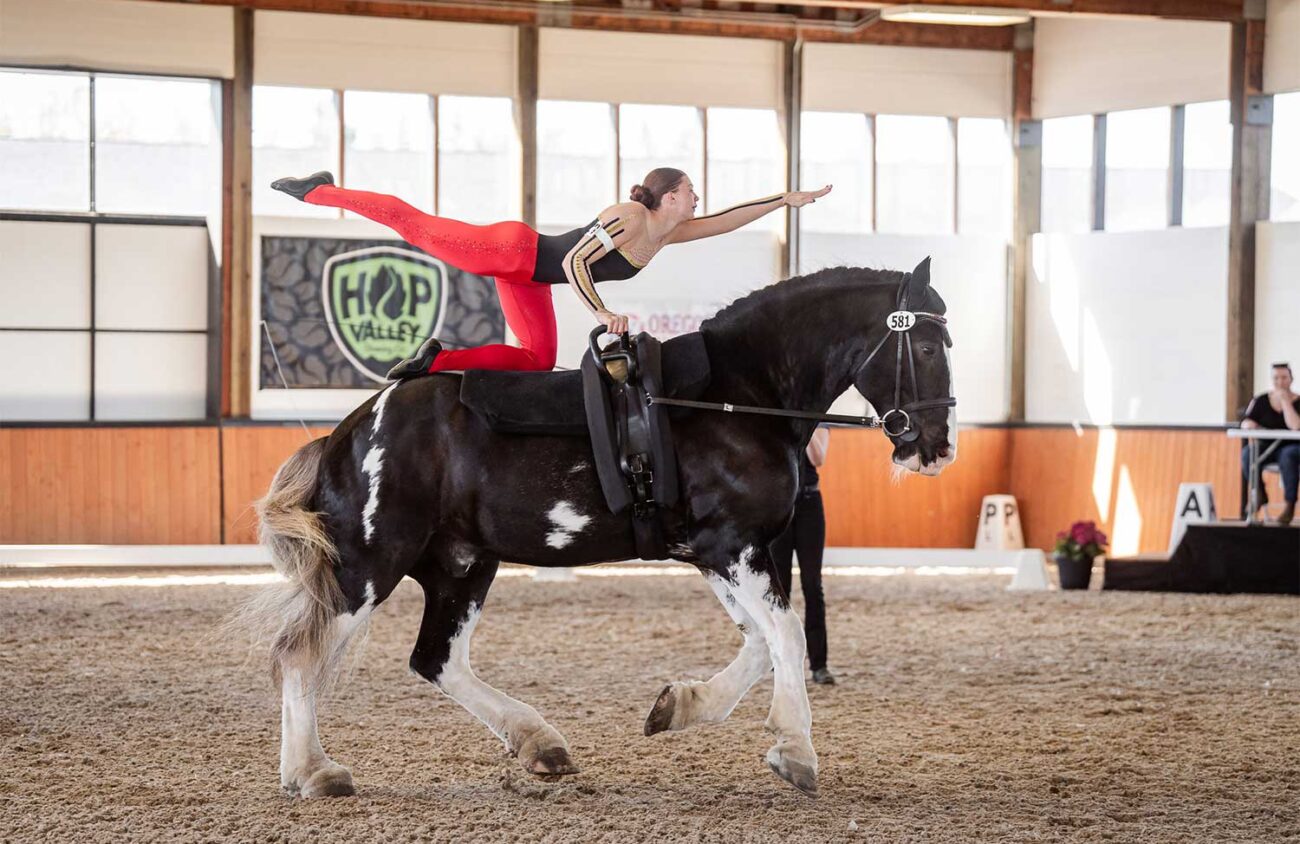A vaulter runs alongside a cantering horse. She wears a full body leotard, red lipstick, black eyeliner and her hair in a bun. Grabbing a handle secured to a pad on the horse’s back, she hoists herself up, gently landing in a kneel. She stands up, leaps and does handstands while her horse, not batting an eye, canters 15-meter circles under her.
“It’s just like a gymnastics performance would be,” says Patty Littmann, the manager of the 2024 Mozart Memorial Vaulting Classic.
Silver Tail Farm in Creswell hosted the May 8-12 event where international and national vaulting teams had the chance to qualify for the Fédération Équestre Internationale vaulting championships coming up in July in Switzerland.
Teams came from Canada, Michigan, Oregon, Washington and California. Littmann says there were about 25 horses at the event. Each team, or squad, has around six members and shares the horse they practice and compete on.
Littmann says vaulting is the perfect sport for kids who love horses and gymnastics, and since a squad shares the expenses that come with caring for a horse, it is more affordable than equestrian sports, like show jumping, where each rider needs their own horse.
The FEI says equestrian vaulting came to the U.S. about 60 years ago. It was popular in Europe throughout the 20th century, and was part of the 1920 Olympic Games in Antwerp, Belgium. The sport was also featured as an artistic showcase in the 1984 Los Angeles Olympic Games and the 1996 Atlanta games. Though it hasn’t recently been given Olympic recognition, it was added to the FEI World Equestrian Games in 1990, an event that takes place every four years and features equestrian disciplines.
During vaulting routines, horses are hooked to a long rope called a lunge line and guided around a 15-meter circle by a person called a lunger.
“The horse has to completely disregard what’s going on on their back because the vaulters are using everything. They have to stand on the head, they stand on the tail, they stand on either side, they do backflips,” Littmann says.
Craig Coburn, an FEI judge with 30 years of judging experience, says the first thing vaulting judges look for is harmony between the horse and the vaulter. For example, judges look for how soft a vaulter lands on the horse’s back following an acrobatic trick, he says.
Coburn says the horse and vaulter are judged to create a combined score out of 10. Horses are judged on things like relaxation and rhythm while vaulters are scored on criteria like body control, posture and flexibility, according to the 2024 FEI Vaulting Guidelines.
Vaulters compete in compulsories individually and freestyles as a squad, Coburn says. Compulsories are a set of uniform exercises to be performed at each squad members’ individual skill level, he says.
“They do a freestyle in which all six vaulters rotate, vaulting on the horse in a very artistic fluid way. Sometimes there’s one person on the horse or sometimes there are two, and sometimes there are three depending on the abilities of the vaulters and the training level of the horse,” Coburn says.
Vaulting is the safest equestrian sport, and there are rarely injuries or concussions, Littmann says. Vaulters build foundational skills like balance, and they learn how to fall correctly and safely before they even get on a horse, she says.
Littmann says the ages of competitors at the event ranged from three years to mid-20s. The little kids vault on ponies at a walk or jog, she says. Littman says vaulting is definitely a youth sport, and vaulters tend to stop in their mid-to-late 20s
“Just like a gymnast, I mean, your body finally says, OK, I can’t do these movements anymore,” she says. “By the time they get to that age, this is not a career. In other words, they’re not going to go off and become a vaulting coach or anything like that. There’s just not that kind of money. They’re usually off doing something else.”
